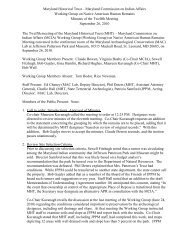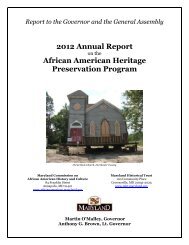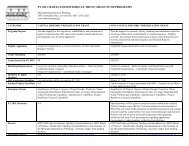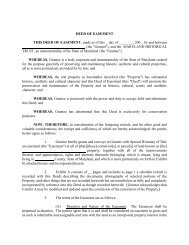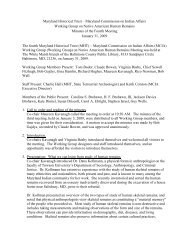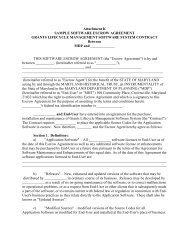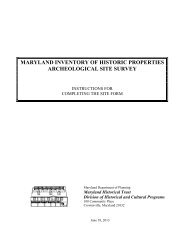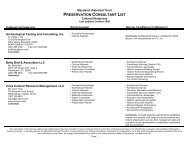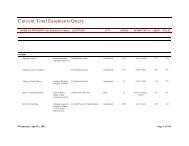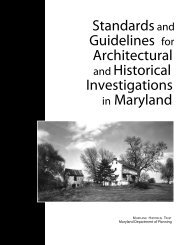The Maryland Preservation Plan - 2005 - Maryland Historical Trust
The Maryland Preservation Plan - 2005 - Maryland Historical Trust
The Maryland Preservation Plan - 2005 - Maryland Historical Trust
- No tags were found...
You also want an ePaper? Increase the reach of your titles
YUMPU automatically turns print PDFs into web optimized ePapers that Google loves.
<strong>The</strong> <strong>Maryland</strong> <strong>Preservation</strong> <strong>Plan</strong>, <strong>2005</strong>study of adaptive responses to overpopulation or underpopulation, population composition and populationcontrol. Grave sites provide the physical anthropological data to study stress, mortality, composition, andhealth of prehistoric cultures while site and artifact types and interrelationships change through time. Site typesinclude cemeteries but can also include a range of sites and chronological diagnostic artifact types.5. RELIGIOUS THEME: <strong>The</strong> religious theme explores the world view of various cultures and the materialmanifestations of spiritual beliefs. Research issues include the analysis of mortuary sites for evidence of thedevelopment of a religious elite and the study of burial practices, artifact analysis to reveal regional trends andinfluences in religious beliefs and study of technological aspects of religious beliefs. Site types include burialmounds, cemeteries, and sites containing features or objects associated with religious activities.6. TECHNOLOGY THEME: Although the technological aspects of a culture form the primary basis of interpretationof all themes, this theme relates primarily to the study of mechanisms developed to transform the socialand cultural environment. Research issues include the identification of changing tool type styles, the identificationof different functions of tools, replication, experimental and living archaeology, as well as studies of storage,transportation, and housing technologies. All sites containing artifacts or features can contribute to this theme.7. ENVIRONMENTAL ADAPTATION THEME: <strong>The</strong> environmental adaptation theme seeks geological and otherdata to reconstruct environmental changes and explores prehistoric adaptive responses to those changes.Research studies include analysis of changes in sea level, forest and animal compositions and the resultantchanges in carrying capacity, the energy efficiency of various procurement and feeding strategies, and theculture processes which explain the perceived responses to the changing environmental conditions. All sitetypes are included in this theme.32HISTORIC PERIOD THEMES (NOTE: <strong>The</strong> activities and resource types listed under each theme are notcomprehensive; others may be identified as relevant.)1 . AGRICULTURE: <strong>The</strong> agriculture theme relates to crop and livestock production and includes the followingresource types: small family farmsteads, plantations, tobacco farms, grain producing farms, livestock/dairy farms,orchards and agribusiness.2. ARCHITECTURE, LANDSCAPE ARCHITECTURE, COMMUNITY PLANNING: <strong>The</strong>se themes encompassthe history of design and construction in architecture, landscape architecture, and the planning of towns andcities. Resource types include impermanent structures, rural vernacular, urban vernacular, great architecturallandmarks, national styles, parks, gardens and landscaped cemeteries, town and village plans, urban design,planned communities and company towns.3 . ECONOMIC (COMMERCIAL AND INDUSTRIAL): Commercial activities include trade, finance, business, andcommercial services. Examples of resource types are banks, other financial areas (real estate, insurance, etc.),trading posts, stores, market buildings, restaurants, hotels, taverns, gas stations, and other services. Industrialactivities relate to the extraction, production and processing of materials, such as quarrying, mining, manufacturing,lumbering, technology, electronics, pottery, textiles, food gathering and processing, brewing and distilling, fuel,building materials, tools, transportation, seafood, and many other industries. Resource types associated withindustry are quarries, mills, factories, breweries, floating vessels and shipyards, mines, forges and furnaces, kilns,laboratories, power plants, dams, tanneries, and other small industrial sites. Many forms of communication also areincluded under commerce and industry, such as telegraph, telephone, radio and television.4. GOVERNMENT/LAW: This theme studies governmental systems, political activities and events, legalsystems, important political/governmental events in history (such as treaty signings), and political leaders.Types of resources which represent this theme are city halls, town halls, courthouses, police departments, jails,post offices, fire departments, public works projects, other types of government buildings, and sites of importantgovernmental events or places associated with governmental leaders.5. MILITARY: This theme includes military activity, battles, strategic locations, and events important in militaryhistory. It includes the following resource types: armories, fortifications, battlefields, camps, travel routes,military bases, military prisons, and strategic military points such as crossings and lookouts.6. RELIGION: This area of study examines places of worship, religious training and education, and administrationof religious facilities. Churches, meeting houses, synagogues, mosques, temples, convents, monasteries,missions, shrines, and sacred places are resource types associated with this theme.7. SOCIAL/EDUCATIONAL/CULTURAL: <strong>The</strong>se themes encompass social, educational, and cultural activitiesand institutions; human services, welfare, charitable, fraternal, and community organizations; the fine arts andperforming arts (painting, sculpture, dance, drama, music); literature; social and recreational gathering facilities;entertainment and leisure activity; and broad social, cultural, or intellectual movements. Resource types includelibraries, museums, schools, colleges, hospitals, orphanages, fraternal and social meeting halls, communitycenters, theaters and concert halls, places associated with writers, artists, performers, resorts, amusement parks,



